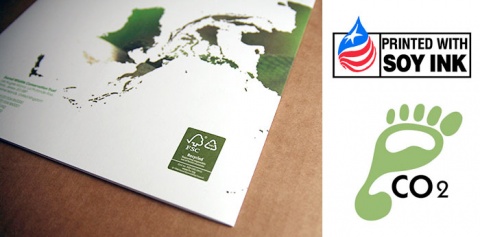“Going green” is more than just a buzz phrase these days. Today corporations are incorporating green practices into their policies, procedures, and even company cultures. The printing industry is a large part of marketing, but with the growing digital age, printing has received some scrutiny for not being so “green.” On the other hand, the ever-growing industry of electronic devices (for viewing those digital marketing pieces) is creating more and more electronics for our landfills. So, how green is it, really? But that’s another story for another day.
In marketing, print still has a place, and as far as we can see, always will. Print marketing has changed over the years, but marketers are very aware of how print materials reach their customers. Think about the QR code or the Augmented Reality Aurasma App. Both of these begin with printed materials and connect the user to the online world.
Eco-friendly marketing is on the rise, and it starts with printing. There are several things to consider when looking for green printing options.
First, not all paper is made the same way or sourced in the same way.
It is important to choose paper that is sourced from a forest and made in a mill that practices sustainability principles. Look for paper that is made from post-consumer waste (at one point was someone else’s paper) or recycled (pre- or post- consumer waste). There are certifications that printers can attain to designate their participation in the practices. The Forest Stewardship Council (FSC) is a non-profit organization that seeks to protect forests by setting standards to ensure that forests are properly managed and maintained. Printers can obtain a Chain-of-Custody Certification from the FSC as a designation of their commitment and continual practices with the FSC-certified materials.
Next, consider the inks.
Vegetable-based or soy inks are the most eco-friendly inks because of their low VOCs. Volatile organic compounds (VOCs) can have negative health effects and are not environmentally friendly. Traditional printing uses petroleum-based inks. Petroleum is not a renewable resource, and it releases a high amount of VOCs.

Finally, printing and shipping techniques make a difference, too.
Be sure that you are printing an accurate amount for your project. Don’t overprint and check the quantity as accurately as the quality. Consider how you are distributing your piece. Much of this will play into the design, so think green from the beginning. Some factors to consider are size, shape and number of pieces.
In addition to printing, your shipping can be green as well. For example, Greenerprinter.com partners with Carbonfund.org to offset emissions from shipping methods. They have many shipping options and use the weight and size of your shipment to determine the best method. Of course, you can also buy your own carbon offsets at Carbonfund.org to offset your own shipping emissions.
Talk to your printer and understand what green practices they have.
Inquire about what kinds of papers and inks your printer uses. Understand what papers and coatings are appropriate for your projects.
If your current printer is not using eco-friendly practices, look for another printer who can meet your project needs and budget. Many green printers have online services, too, that can be just as competitive as your local printer. Check out these green printers with online services.
Greenerprinter
Barefoot Press
Green Printer
The most important thing to “going green” is your relationship with a printer. Get to know your printer and let them know your project needs. This will give you more options. Chances are they understand the printing industry better than you, but you should come prepared with the right questions and let them know your green goals!